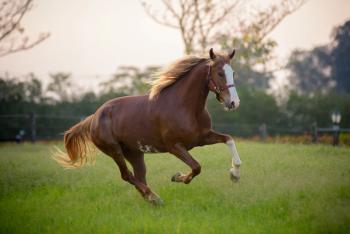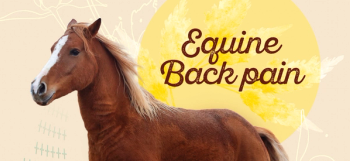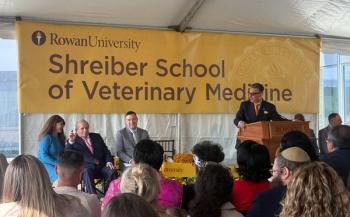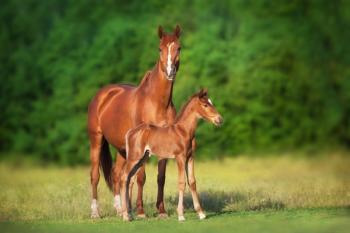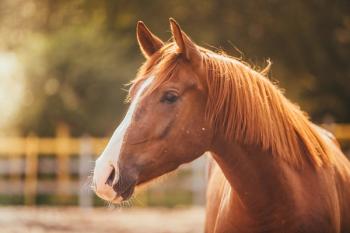
The new approach to parasite control--the veterinarian's role (Proceedings)
The once stodgy world of veterinary parasitology is undergoing a revolution.
“Now and in the future, effective anthelmintic drugs will need to be viewed as resources that are extremely valuable and not easily renewable.”
The once stodgy world of veterinary parasitology is undergoing a revolution. The reason for this shift is simple: the worms are winning. Parasites are developing resistance to anthelmintics at a faster rate than new wormers can be developed. Parasite control in the future will need to be based on a total control strategy, with anthelmintics reserved for the animals with large worm burdens and those with clinical signs of parasite infection. This change to a strategic parasite control program and targeted deworming represents a huge opportunity for equine veterinarians. Instead of being a dispenser of drugs – just one source of product out of many – the veterinarian is needed to help stable owners devise management strategies to decrease the number of infective larvae a horse will be exposed to.
The expectation that equine veterinarians are the professionals who will assist owners as they navigate the new recommendations and treatment plans is being currently stated in publications aimed at the horse owner and by the anthelmintic manufacturers themselves. To quote from the Pfizer Individual Deworming Program webpage: “Your veterinarian will analyze the data collected from your horse, herd and farm to customize an easy-to-follow plan that fits the individual needs of your horse.” As is evident from that statement, this is a time of both enormous opportunity and challenge for the equine practitioner. Ironically, the last time the veterinary profession was so important in equine parasite control was in the days when tube worming was the norm.
Lessons from small ruminants
Abomasal parasites, particularly Haemonchus contortus, are among the most important pathogens in small ruminant species. They cause fatal blood loss anemia in sheep and goats. What is more, resistance has been documented against all classes of anthelmintics. In the 1990's, small ruminant producers were faced with a situation where no available anthelmintic was effective against abomasal worms. Out of necessity, emphasis has switched away from a quest to find a better drug towards managing a group of animals in a manner that would maximize the number of sensitive nematodes and also select for genetically resistant animals.
Worm burdens are assessed by means of FAMACHA scoring. Developed by a South African researcher, the scoring system uses conjunctival color to assess degree of anemia. Animals with pink conjunctiva are not anemic and no wormer is given. Animals judged to be anemic are either treated or culled depending on the management strategy.
Horses are not sheep!
Applying small ruminant parasite control strategies to horses without appreciating the huge differences between the species, both host and parasitic, is bound to fail. Most importantly, owners are extremely unlikely to cull heavily parasitized horses. Thus, one of the main reasons to test individual animals is a moot point in equine medicine. Secondly, small ruminant parasite strategies are targeted at one class of parasite exclusively –abomasal nematodes. While small ruminants do suffer from other species of parasite, they are an insignificant problem to overall animal production. In contrast, there are several different parasites - nematode, trematode, and insect parasites cause disease in horses.
The new paradigm for parasite control in horses focuses on cyathostomes (small strongyles), basically substituting small strongyles in the place where a small ruminant producer would concern itself with Haemonchus. Due to their short pre-patent period and widespread resistance, it makes sense to concentrate on this parasite in this way. Practitioners need to be aware, however, that other parasites – such as ascarids in younger animals, large strongyles, bots, and tape worms cannot be forgotten, and may necessitate other strategies to control.
Practices that are not sustainable
Anthelmintic resistance was first identified in horses over 30 years ago. Resistance of small strongyles to every class of dewormer has been documented. It has also been found experimentally that indiscriminate use of anthelmintics and giving anthelmintics at inappropriate doses leads to the rapid development of resistant worm populations. Using a calendar based strategy, i.e. worming a horse every 6 to 8 weeks no matter what, is one of the factors driving up the populations of worms with genetic resistance for anthelmintic products. There is no experimental evidence to support the notion that rotating wormers decreases the rate of anthelmintic resistance development, and it is no longer recommended.
Where we go from here
The emphasis in the newer control strategies is on the diagnosis of parasites – both in qualitative and quantitative terms. Owners must be educated to the reality that eliminating all parasites in all horses is not a realistic proposition. Parasite control efforts should be geared towards decreasing the number of infective larvae in the environment. This is done by identifying which horses are shedding large numbers of eggs, then treating only those animals. The first step at any location is to assess the overall parasite burden by performing fecal egg counts on all the horses. If very large populations of horses are being tested, performing fecal egg counts on representative percentage will give an estimate of overall parasite burden.
To perform fecal analysis and egg counts correctly requires technical skills that are quite easy for a practitioner or veterinary technician to master. In addition, many commercial laboratories offer quantitative and qualitative fecal egg counts on a fee for service basis. The McMaster method is generally sufficient when ascertaining parasite burdens. Because the concern is identifying horses shedding large numbers of eggs, not in counting very small numbers, more elaborate counting methods are generally not required.
A horse with a fecal egg count of 200 eggs per gram or less is not shedding sufficient numbers of parasites to warrant treatment. A count of ≤ 500 eggs per gram indicates treatment may be indicated. Generally, worming the top 20% of fecal shedders will eliminate 80% of the eggs shed onto pasture. The parasites in the untreated horses and the larvae in the pasture represent the refugia. Refugia is the term given to the percent of the overall parasite population that has no exposure to anthelmintics and thus no selection pressure to develop resistance. The larger the refugia, the more slowly anthelmintic resistance will develop.
Pasture and manure management
Parasite larvae can survive for long periods of time within a fecal ball on pasture. They are rapidly killed by the temperatures manure reaches when it is composted and rapidly desiccated as manure pats are spread apart during hot, dry times of the year. Thus, it makes sense to compost manure from stalls for several days before spreading onto pasture. Dragging pastures during the summer will deprive larvae of formed manure pats and decrease infective larval loads. Dedicated horse owners, particularly those with small pastures and high stocking densities, can use the “kitty litter box” approach. Daily removal of manure from pasture has been documented to decrease parasite levels in horses. Modified vacuum systems can be purchased that allow owners to manually remove manure daily. If this approach is followed diligently, eggs will be removed before larvae can emerge and become infective, and the need to use wormers will be minimized.
Larvae require relatively high humidity to develop into infective stages. Thus hot, dry summers and temperatures below freezing are not conducive to larva maturation, and horses are unlikely to be infected when grazing pastures during these times of the year. Conversely, lush wet pastures during warm, humid conditions allow rapid maturation of larvae to infective stages and predispose to infection. Allowing pastures to rest – particularly over the winter or dry months of summer – will reduce infective larval loads. Cross-grazing with ruminant species can decrease larval burdens as cattle, sheep, goats, or camelids will act to vacuum up larvae but do not shed equine parasites.
Any amount of pasture management is better than doing nothing. It is better to divide a 2-acre pasture into 2 one-acre lots and have horses alternate sides than to allow access to both acres at all times. Unless there is an extreme overgrazing situation, horses generally divide their pasture areas into “lawns” and “roughs.” They graze on the lawns, often taking grass down to the dirt, while defecating in the roughs, places where the grass is not eaten. This behavior is believed to be a natural parasite control strategy. While it may decrease a horse's worm burden below what it might be otherwise, the tendency of horse to only graze on areas of the pasture removed from their manure does not prevent ingestion of infective larvae and can not be counted on as a parasite control strategy.
Assessment
Periodic fecal egg reduction testing should be performed in order to ensure that the chosen anthelmintic is remaining effective. A single anthelmintic should be used to control small strongyles until resistance is documented by failure of egg numbers to decrease in fecal egg count reduction tests and by shortening of the egg reappearance period.
Large strongyles and bots
The larval stage of the large strongyle, Strongylus vulgaris, causes thromboembolic colic -the most devastating parasite-related problem seen by equine practitioners. The low parasite numbers and long pre-patent period makes the large strongyle a poor candidate for strategic deworming strategies. Unless a horse is stabled at all times or housed alone it should receive deworming to prevent verminous arteritis twice per year.
Bots can affect horses owned by the most diligent manager as the adult flies have a large range and can travel over fence lines. Unless a massive infestation exists, bot larvae in the stomach do not generally cause disease. The presence of eggs on the hair and mane will alert an owner if there is a problem. Treatment of bots is best done after the first hard frost of the winter in temperate areas after the adult flies are dead. An anthelmintic that is effective against insects, not just nematodes, is needed to treat bots. Of the current commonly used products, the avermectins have activity against insect species. Planning one of the horse's biannual wormings against S. vulgaris to also target bots will decrease the overall number of treatments needed.
Ascarids
Parascaris equorum is the major parasite of concern in foals and young horses between the ages of 3 and 18 months of age. Affected foals grow more poorly and have decreased protein when compared to unaffected animals. Massive infestations cause impactions and GI necrosis. Ascarid eggs do not hatch, but remain in the environment for years protected by their thick egg capsules. Unlike strongyles, fecal egg counts of ascarids correlate with overall worm burden, making assessment of the degree of infection relatively easy once a patent infection has developed.
Fecal egg counts aimed at identifying ascarid eggs should be begun at 3-4 months of age and performed on a monthly or bimonthly basis until a year of age. To prevent the build up of eggs in the environment, foals should be treated with a product that is effective against ascarids if eggs are observed. If a foal is heavily parasitized with high fecal egg counts, care should be given when worming to prevent an ascarid impaction from developing.
Summary
In summary, the goals of strategic deworming programs are to prevent the development of negative health effects due to parasites in horses as well as slow down the development of anthelmintic resistance in small strongyles. The veterinarian's role is to assess overall worm burdens and species, and then treat each case in an individual manner. Both using an old-fashioned cookbook approach or believing that a small strongyle control strategy is sufficient to address all the major parasites of horses are bound to fail in the long run.
Newsletter
From exam room tips to practice management insights, get trusted veterinary news delivered straight to your inbox—subscribe to dvm360.


